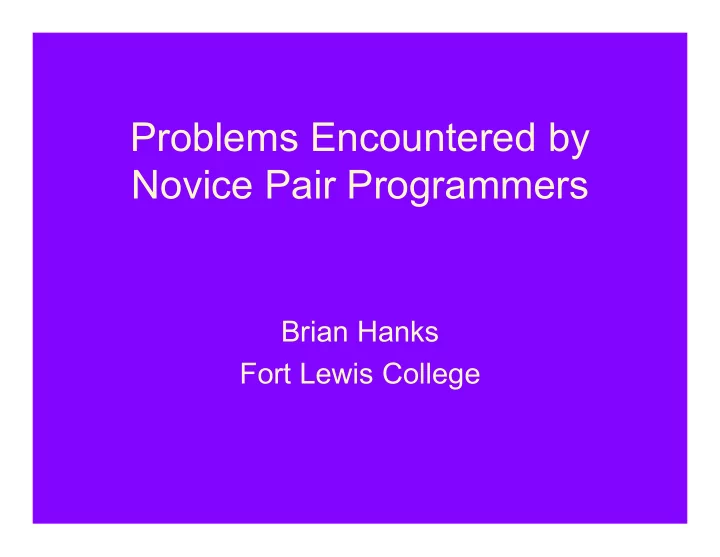

Problems Encountered by Novice Pair Programmers Brian Hanks Fort Lewis College
Background • Robins, Haden, Garner at University of Otago, NZ. • Recorded every student request for help during CS1 closed labs over 2 year period.
Background • Coded problems using 28 problem codes in 3 problem categories – Background: problems with tools, understanding the task (3 codes) – General: basic OO concepts, trivial mechanics (4 codes) – Specific: assignment, arrays, method calls, loops (21 codes) • Trivial Mechanics: 16% of all problems
Research Motivation • Otago students worked on programs by themselves. • Pair programming provides many pedagogical benefits. • Question: is the distribution of problems encountered by pairs the same?
Research Questions 1. Do students who pair program ask for help on the same types of problems as students who work alone? 2. Do pairing students have as many problems as soloing students?
Hypotheses H1 The proportion of trivial mechanical problem will be smaller for paired students. H2 Paired students will require assistance on fewer problems.
CS1 at Fort Lewis College • 2 hour combined lecture/lab • Objects-first approach • Similar material covered • Much smaller classes
Procedure • Captured every problem encountered by paired students in CS1 for 2 semesters. • Coded problems after end of each semester. • Minor differences in course material – 2 new Specific problem codes
Data Collection • Otago – 470 students, 19008 problems • Fort Lewis – 15 pairs, 331 problems • Data normalized to facilitate comparison
Distribution by Category
Distribution by Problem Code
Problem Counts Otago FLC Solos Pairs Num Solos or Pairs 470 15 Num Problems 19008 331 Problems per 40.4 20.7 Solo or Pair Problems per 1.62 0.67 Solo or Pair per Lab
Results • H1 not supported by this study – Similar proportions of problem types in both conditions – Percentage of trivial mechanical problems nearly identical • H2 supported – Pairs experienced 41% as many problems per lab as soloing students – On a per student basis, pairing students ask for help only 25% as often as soloing students.
Discussion • Paired students able to resolve more problems on their own, but problem distribution the same • Fundamental Ratio of Problem Types? – Do novices get stuck on the on the same types of problems regardless of instructional approach? – What about more experienced programmers?
Thank you • Questions?
FLC: Problems per Lab
G4 Distribution by Lab
Recommend
More recommend